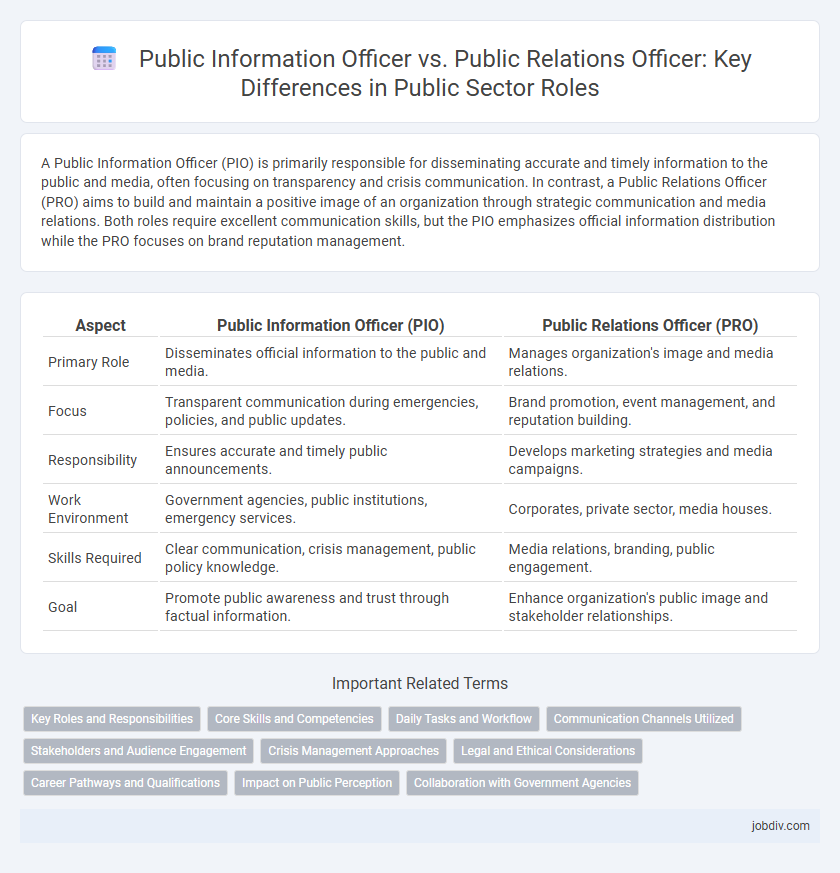A Public Information Officer (PIO) is primarily responsible for disseminating accurate and timely information to the public and media, often focusing on transparency and crisis communication. In contrast, a Public Relations Officer (PRO) aims to build and maintain a positive image of an organization through strategic communication and media relations. Both roles require excellent communication skills, but the PIO emphasizes official information distribution while the PRO focuses on brand reputation management.
Table of Comparison
| Aspect | Public Information Officer (PIO) | Public Relations Officer (PRO) |
|---|---|---|
| Primary Role | Disseminates official information to the public and media. | Manages organization's image and media relations. |
| Focus | Transparent communication during emergencies, policies, and public updates. | Brand promotion, event management, and reputation building. |
| Responsibility | Ensures accurate and timely public announcements. | Develops marketing strategies and media campaigns. |
| Work Environment | Government agencies, public institutions, emergency services. | Corporates, private sector, media houses. |
| Skills Required | Clear communication, crisis management, public policy knowledge. | Media relations, branding, public engagement. |
| Goal | Promote public awareness and trust through factual information. | Enhance organization's public image and stakeholder relationships. |
Key Roles and Responsibilities
Public Information Officers (PIOs) primarily manage the dissemination of accurate and timely information to the community and media during emergencies, ensuring transparency and public safety. They are responsible for crafting official statements, coordinating press releases, and serving as a liaison between government agencies and the public. Public Relations Officers (PROs) focus on shaping and maintaining a positive organizational image through strategic communication, managing media relations, and promoting brand reputation across various platforms.
Core Skills and Competencies
Public Information Officers excel in crisis communication, regulatory compliance, and accurate information dissemination, emphasizing transparency and credibility. Public Relations Officers specialize in brand management, media relations, and audience engagement, focusing on reputation building and strategic messaging. Both roles require strong communication skills, media literacy, and stakeholder relationship management but differ in scope and primary objectives.
Daily Tasks and Workflow
Public Information Officers primarily manage the dissemination of accurate and timely information to the public and media, focusing on crisis communication and official statements. Public Relations Officers develop and execute strategies to enhance the organization's image, coordinating campaigns, media relations, and stakeholder engagement. Daily tasks of Public Information Officers include monitoring news coverage and drafting press releases, while Public Relations Officers handle event planning, social media management, and brand promotion.
Communication Channels Utilized
Public Information Officers (PIOs) primarily utilize official government channels such as press releases, public service announcements, and emergency alert systems to disseminate accurate and timely information to the public. Public Relations Officers (PROs) leverage diverse media platforms including social media, corporate websites, and influencer partnerships to enhance brand perception and engage target audiences. Both roles employ strategic communication techniques tailored to their specific organizational goals and stakeholder needs.
Stakeholders and Audience Engagement
Public Information Officers (PIOs) primarily manage communication with government stakeholders, ensuring accurate and timely dissemination of official information to the public and media, thereby maintaining transparency and trust. Public Relations Officers (PROs) focus on building and nurturing relationships with diverse audiences, including customers, partners, and community members, to enhance organizational reputation and engagement. Both roles require strategic communication skills, but PIOs emphasize authoritative information sharing, while PROs prioritize persuasive messaging and stakeholder rapport.
Crisis Management Approaches
Public Information Officers (PIOs) specialize in delivering accurate, timely information to the public during crises, ensuring transparency and trust through official channels. Public Relations Officers (PROs) manage the organization's reputation by crafting strategic messages to mitigate negative impacts and maintain stakeholder confidence. Both roles coordinate closely to align factual communication with brand image preservation, optimizing crisis response effectiveness.
Legal and Ethical Considerations
Public Information Officers (PIOs) are legally mandated to provide accurate, timely, and transparent information to the public, adhering to government regulations and ethical standards to maintain public trust and accountability. Public Relations Officers (PROs) focus on managing an organization's image and communications, balancing promotional messaging with ethical responsibilities to avoid misinformation and protect stakeholder interests. Both roles require strict compliance with laws such as freedom of information acts and ethical codes to ensure transparency, confidentiality, and the integrity of public communication.
Career Pathways and Qualifications
Public Information Officers (PIOs) typically require a background in communications, journalism, or public administration with skills focused on media relations and crisis communication, often working within government agencies to manage information dissemination. Public Relations Officers (PROs) generally pursue degrees in marketing, public relations, or business, emphasizing brand management and strategic communication for private corporations or nonprofits. Career pathways for PIOs often involve public sector roles and regulatory compliance, while PROs advance through corporate communications, media strategy, and stakeholder engagement positions.
Impact on Public Perception
Public Information Officers (PIOs) focus on delivering accurate, timely government information that builds public trust through transparency and accountability. Public Relations Officers (PROs) concentrate on managing organizational image and promoting positive narratives to shape public perception strategically. The distinct roles influence public perception by balancing factual communication with reputation management, crucial for maintaining credibility and public confidence.
Collaboration with Government Agencies
Public Information Officers (PIOs) directly manage communication and information dissemination from government agencies to the public, ensuring transparency and timely updates. Public Relations Officers (PROs) focus on building and maintaining the agency's image and relationships with external stakeholders, including media and community groups. Effective collaboration between PIOs and PROs enhances coordinated messaging, crisis communication, and public trust in government operations.
Public Information Officer vs Public Relations Officer Infographic

 jobdiv.com
jobdiv.com